The crested newts, which are protected in Europe and Lithuania, are in danger of disappearing completely in Taurage – because the construction of the small detour Naujoji gatvė on the side of the Oko forest has become an insurmountable obstacle for these animals. Although Kastytis Ačas from Tauragi saves the little ones who are on the verge of extinction as if on purpose – in the morning and in the evening, he moves them to a safe place, clinging to the side of the street, but still a lot of them die because they freeze.
Kastytis Ačas publicized the problem and the photos in the Lithuanian Herpetological Society, which includes reptile and amphibian lovers: “The question of survival arose. It’s sad, the detour is a trap, Tauragė, I’m saving… Yesterday’s record was 19 rescued, otherwise up to 10 every day, but a lot of small ones died. I move them in the morning and in the evening, on a stretch of about 1.5 kilometers.”
Enthusiasts seeking to preserve as many individuals of this species as possible advise installing fences in that area, moving newts from concrete traps at least once a day, as their migration is currently underway. People wondered why no attention was paid to nature and animals when designing the street, why no research was done on what kind of problem the new building would cause. According to K. Ača, Naujosjis gattis will not be opened soon until the traffic lights are installed, so at least this spring reptiles and amphibians will not be crushed by cars. Although the man rescues the newts, many of the baby newts still die – they freeze to death by clinging to the side, without the slightest chance to overcome the obstacle created in their usual path.
Tauragė district municipality ecologist Otilija Budrytė assured that she had not received any information from residents about the problem with newts, and no one had approached the municipality about this problem.
Digging Ačas rushes to save the dying newts in the mornings and evenings. Kastytis Acho’s photo
– The only way that could probably be done is to install fences like they show on TV or something like that. Then there’s the only problem: the newts still have to go through that path, so someone has to pick them up and move them. This should probably be done by the people themselves, because we don’t have anyone to move tritons in the middle of the work day. I reviewed the practice of other municipalities, the installation of fences is usually initiated by residents. I consulted with the Department of Environmental Protection, usually residents do this. They coordinate with the municipality so that the municipality knows that such an idea is being implemented, – said the ecologist.
The crested newt, which is rarely found in nature (it migrates through Naujaja gatve), is listed not only in the Lithuanian Red Book, but also in the lists of animals protected by the Bern Convention and the European Union Habitats Directives. It is a tailed amphibian of the salamander family, protected in Lithuania since 1991. Sparse populations are known and data on them is still lacking. In many localities, habitat conditions are not sufficiently favorable for the formation of large populations.
The upper part of the newt’s body is gray-black or dark brown, the belly is spotted with orange and black spots. At the time of marriage, males grow a scutellum with a serrated edge. The latter grow up to 18 cm, and females – up to 20 cm. From April to mid-July, they spend in the water, then come out on land and hide in caves under rotting trees and stumps.






